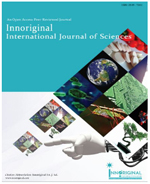EVALUATION OF ACCUMULATED HEAVY METALS IN SOIL AND PLANT BODIES OF Oryza sativa L. and Triticum vulgare L.
Abstract
The Rice and Wheat crops are very important edible species in India, which were also stable food for diet of all the human beings. The main objective of the work is to evaluate the accumulated heavy metal levels in soil and plant bodies through pot culture experiments. The experiments were conducted by in-vitro condition in the department laboratory. The effluents samples were collected the karakambadi and renigunta industrial areas, Andhra Pradesh, India. It has been observed that the crop plant parts were affected by the effluents which were impacted on shoot, stem and root of rice and wheat crop plant parts. The statistical values of plant samples have significantly reduced when compared with control. In this study, water crop plants were subjected to higher doses of lead and cadmium, leads to significantly declined in the growth. The results suggests that water crops are not affected by oxidative stress, in spite of the presence of higher dose of lead and cadmium in the hydroponic medium, as would be anticipated for a species that has efficiently survived in a highly polluted environment.ÂReferences
Rahmani HR. Use of industrial and municipal effluent water in Esfahan province-Iran. Scientific Research and Essay. 2007; 2(3): 84-88.
Mustafa K, Sukru D, Celalettin O, Mehmet Emin A. Heavy metal accumulation in irrigated soil with wastewater. Ziraat Fakultesi Dergisi.2006; 20 (38):64 - 67.
Mishra A Tirpathi BD.Heavy metal contamination of soil, and bioaccumulation in vegetables irrigated with treated wastewater in the tropical city of Varanasi, India. Toxicological & Environmental Chemistry.2008.1-11.
Rattan RK, Datta SP, Chhonkar PK, Suribabu K, Singh AK. Long term impact of irrigation with sewage effluents on heavy metal content in soils, crops and groundwater- a case study. Agriculture, Ecosystem and Environment. 2005; 109: 310-322.
Masto RE., Chhonkar PK., Singh D, Patra AK. Changes in soil quality under long term sewage irrigation in a sub tropical environment. Environ. Geol.2008.
Lokeshwari H, Chandrappa GT. Impact of heavy metal contamination of Bellandur Lake on soil and cultivated vegetation. Current Science. 2006; 91 (5): 622- 627.
Aydinalp C, Marinova S. Distribution and forms of heavy metals in some agricultural soils, Polish Journal of Env. Studies.2003; 12 (5): 629-633.
Cole DC, Diamond M, Bassil K, Heather J. Health risk and benefit assessment in UPA. SSA workshop on health risks and benefits of urban and peri-urban agriculture. Nairobi, Kenya.2003.
Gupta AK, Sinha S, Basant A, Singh KP. Multivariate analysis of selected metals in agricultural soil receiving UASB treated tannery effluent at Jajmau, Kanpur (India). Bull. Environ. Contam. Toxicol. 2007; 79:577- 582.
Wenzel WW, Adriano DC, Salt D, Smith R. Phytoremediation: A plant-microbe based remediation system. p. 457-508. In D.C. Adriano et al. (ed.) Bioremediation of contaminated soils. American Society of Agronomy, Madison, WI.1999.
Jiri, j. Microwave digestion of hardly dissoluble samples, J R N C 2011; 290: 637-642.
Dubey RS. Metal toxicity, oxidative stress and antioxidative defense system in plants. In Reactive Oxygen Species and Antioxidants in Higher Plants. Gupta SD.Ed,. 2011; PP. 177–203
Villiers F, Ducruix C, Hugouvieux V. Investigating the plant response to cadmium exposure by proteomic and metabolomic approaches. Proteomics. 2011; 11(9): 1650–1663.
Sharma P, and Dubey RS. Involvement of oxidative stress and role of antioxidative defense system in growing rice seedlings exposed to toxic concentrations of aluminum. Plant. Cell. Reports. 2007 .
Gamalero,E Berta, G. Glick B.R. The use of microorganisms to facilitate the growth of plants in saline soils M.S. Khan, A. Zaidi, J. Musarrat (Eds.), Microbial Strategies for Crop Improvement, Springer, Berlin, Heidelberg (2009)
Salt DE, Rauser WE. Mg-ATP dependent transport of phytochelatins across the tonoplast of oat roots. Plant Physiol.1995; 107:1293–1301
Guo J, Dai X, Xu W, Ma M. Over expressing GSHI and As PCSI simultaneously increases the tolerance and accumulation of cadmium and arsenic in Arabidopsis thaliana. Chemosphere. 2008; 72:1020–1026.
Blum A. Improving wheat grain filling under stress by stem reserves mobilization. Euphytica. 1998; 100: 77 - 83.
Munzuroglu O, Geckil H. Effects of metals on seed germination, root elongation, and coleoptile and hypocotyl growth in Triticum aestivum and Cucumis sativus. Arch Environ Contam Toxicol.2002; 43(2):203-13.
Memon AR, Aktoprakligul D, Zdemur A, Vertii A. Heavy Metal Accumulation and Detoxification Mechanisms in Plants. Turk J Bot .2001; 25 (3):111-121.


